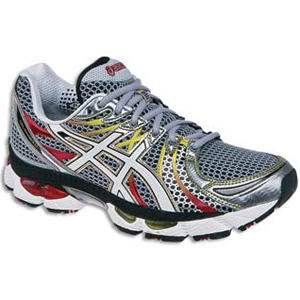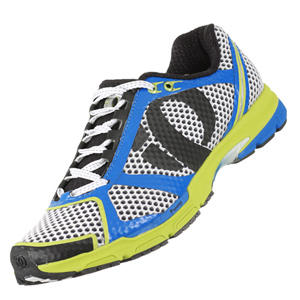
Asics’ historic penetration in the sport of triathlon (25 percent as of two years ago) has been buffeted by the so-called natural running shoe style. The Excel33 is its answer—sort of.
Asics has staunchly defended its view that a sufficient rear-to-forefoot "ramp" should be maintained. Accordingly, this shoe does not have a ramp of 4mm, or 3mm or even less, as is typical in many natural running shoe models, rather the Excel33 is built with a 28mm heel and an 18mm forefoot. This 10mm ramp is in keeping with Asics typical shoe construction that features ramps of 12mm on the average.
This is antithetical to the natural shoe trend, but is in keeping with Asics' view of how shoes ought properly to be made for today’s runners on today’s running surfaces.
If you therefore simply view it as a lightweight trainer you have an exceptional shoe with bounce and cushion that will cause you to look down and make sure what you’re wearing bears the Asics stripes. This is not typical Asics.
The upper is what you can expect from this fine company: It feels light but is still noticeably supportive, similar to the DS Trainer. One departure from other Asics models is the flexibility in the sole. This shoe is much more flexible than most other lightweight trainers from Asics, and bucks a design trend that seems to have been in place, according to my recollection, for the last decade or so.

Asics’ opinion about the shoe—that it grants the foot natural movement—is absolutely true. And it’s still pretty stable in spite of its flexibility. Part of that stability comes from what Asics calls its proprietary Propulsion Trusstic: a plastic shank placed at the outsole under the arch of your foot. It gives the shoe a certain amount of torsional rigidity.
Although it is almost the exact same weight, at 9.9oz, as the DS Trainer the Excel33 feels much lighter when you run. This is the effect given by the springy, bouncy midsole combined with exceptional flexibility. I must admit I enjoyed this feeling, even if I’ve bought into the low-ramp argument, and the heel of the shoe is therefore higher than I’d like.
For those died in the wool Asics users familiar with the GT-21 series, the Kayano and the Nimbus, here’s a shoe you’ll recognize, except it feels lighter and faster. I never felt that the DS Trainer lived up to its potential, because of the limited flex in the forefoot. The Excel33 blows up that criticism.
If you, like Asics, are not prepared to go low-ramp, but you want to get hold of some of that spring and flex making its way into the running shoe market, this is a shoe you must try.
The Excel33—and the other 33 models—give Asics a more complete line of shoes. It’s debatable whether they should label them “natural” running shoes, lest the suggestion the shoes follow this shoe construction theme throughout. But that’s a debate we’ll save for another day.
The Excel33 is available in men’s and women’s sizes and in multiple colors (men above, women below).

[Editor’s note: Our capable editor-at-large for footwear Jeroen van Geelen owns Total Running, one of the more important running and triathlon retail establishments in The Netherlands.]


